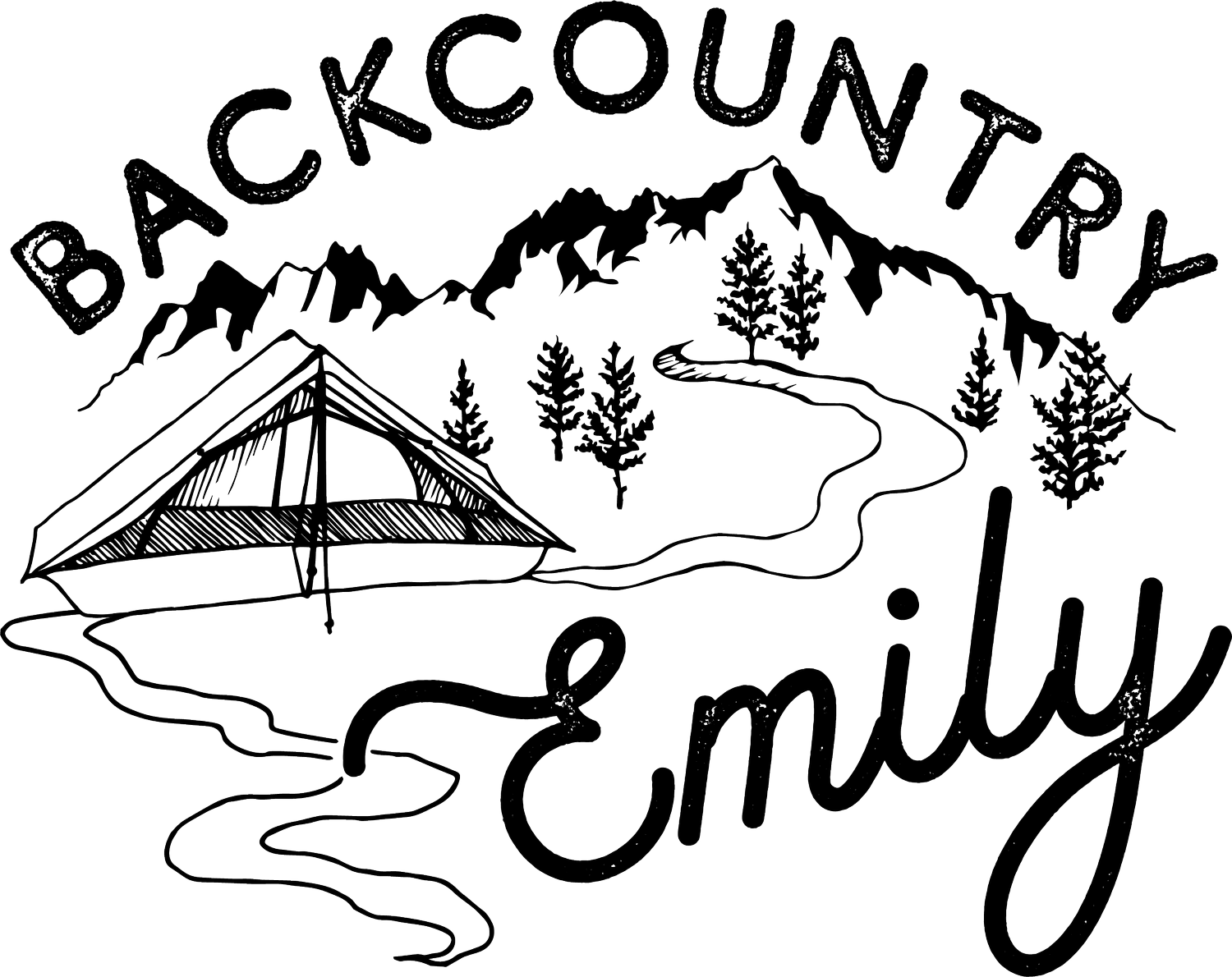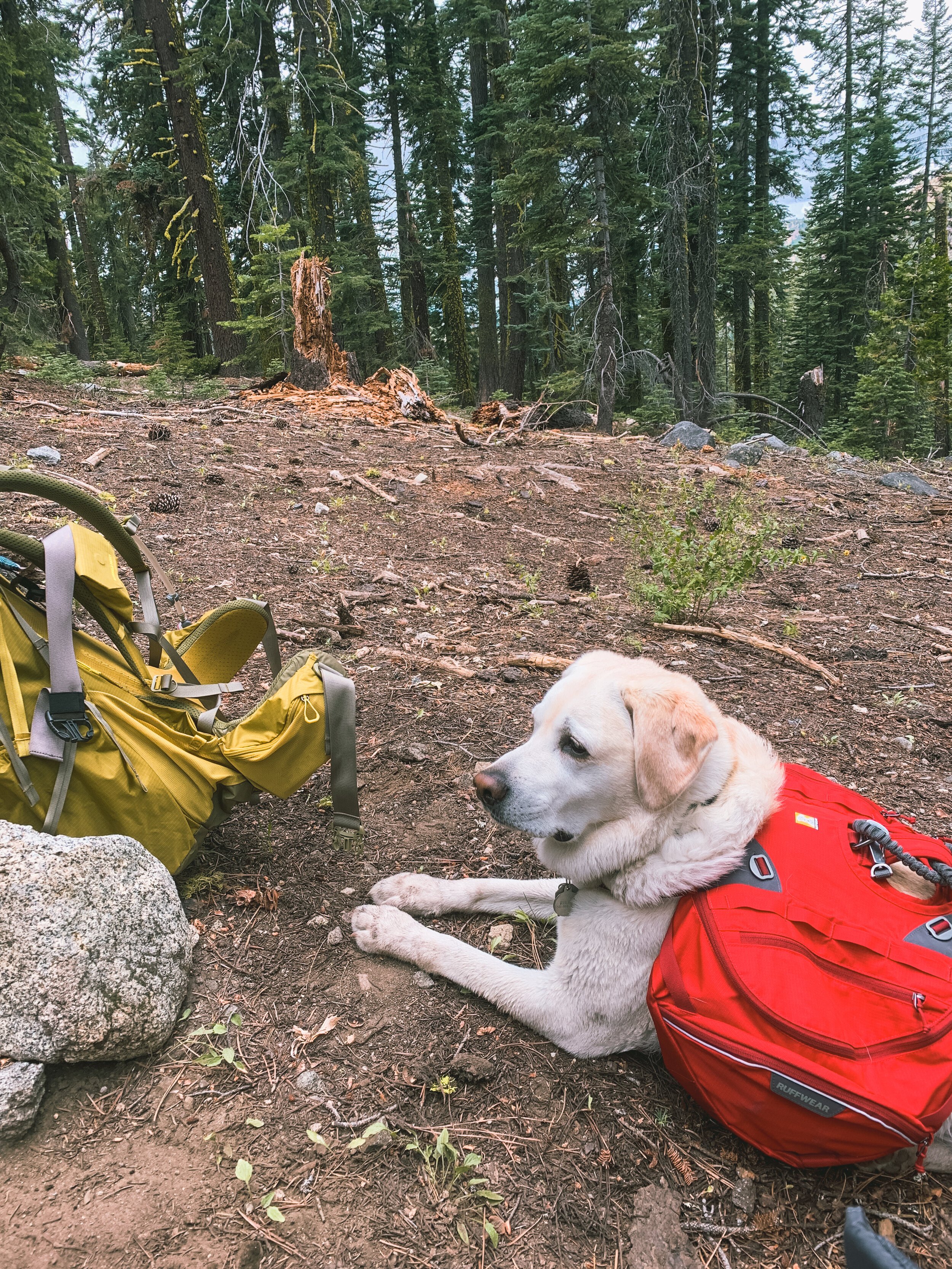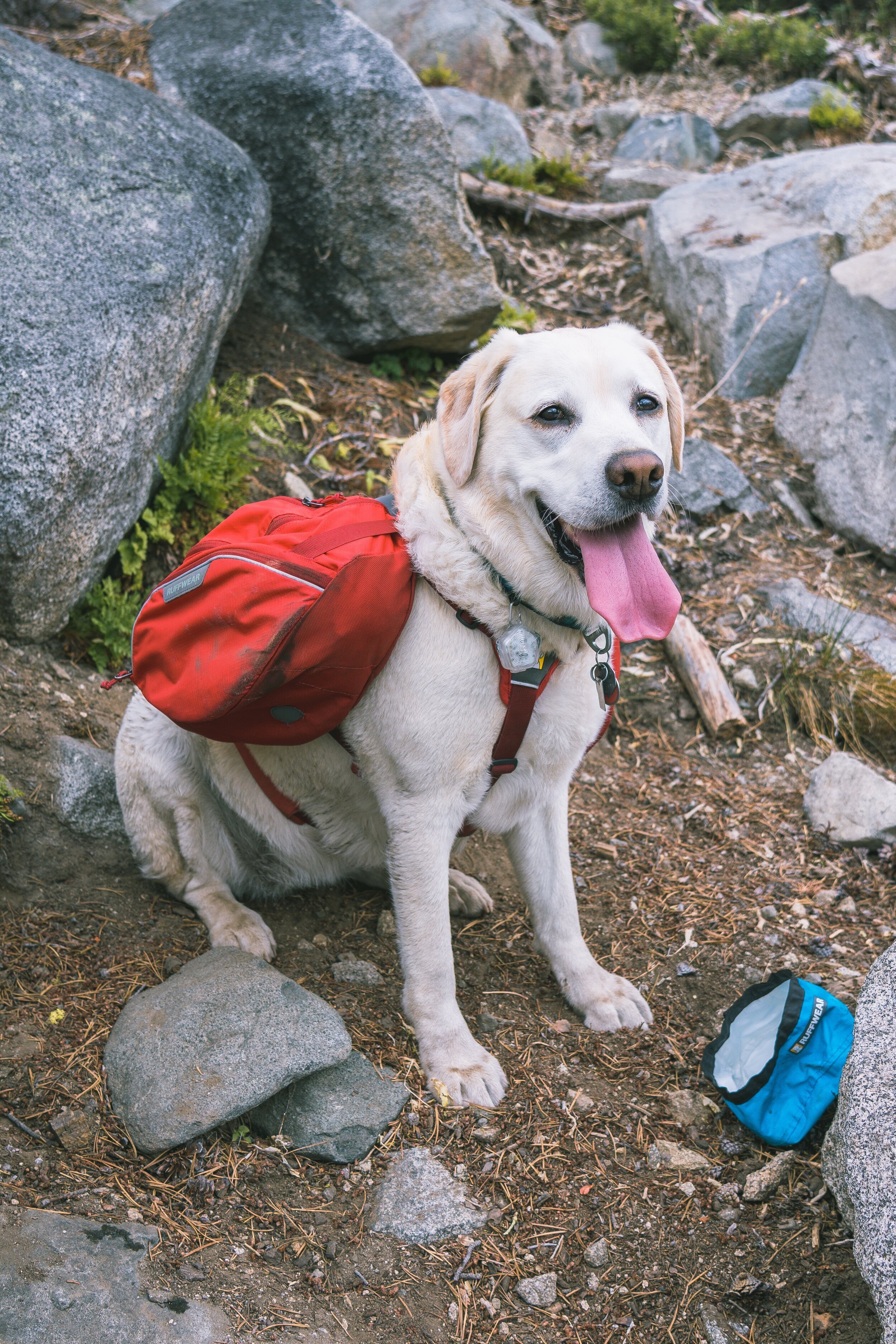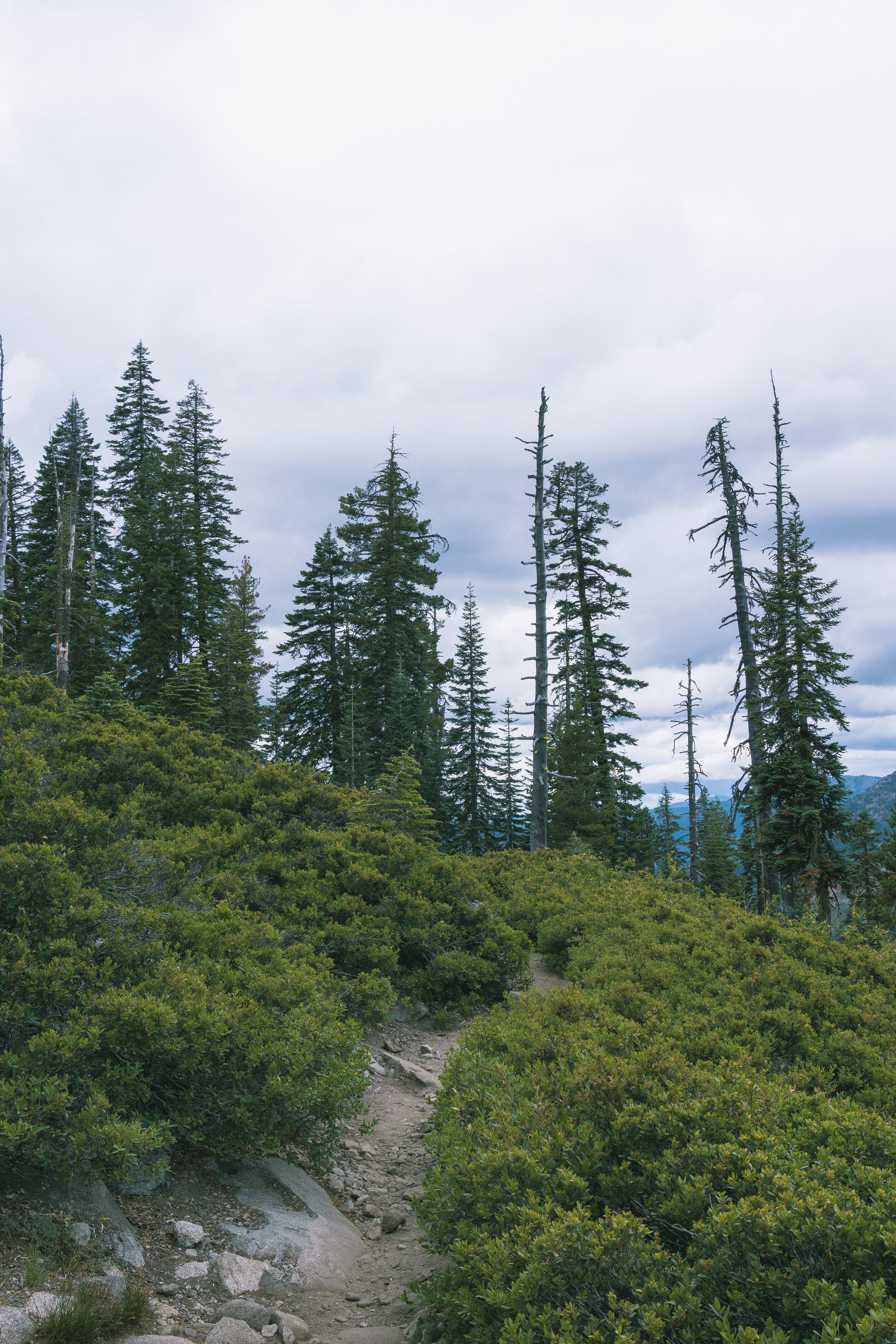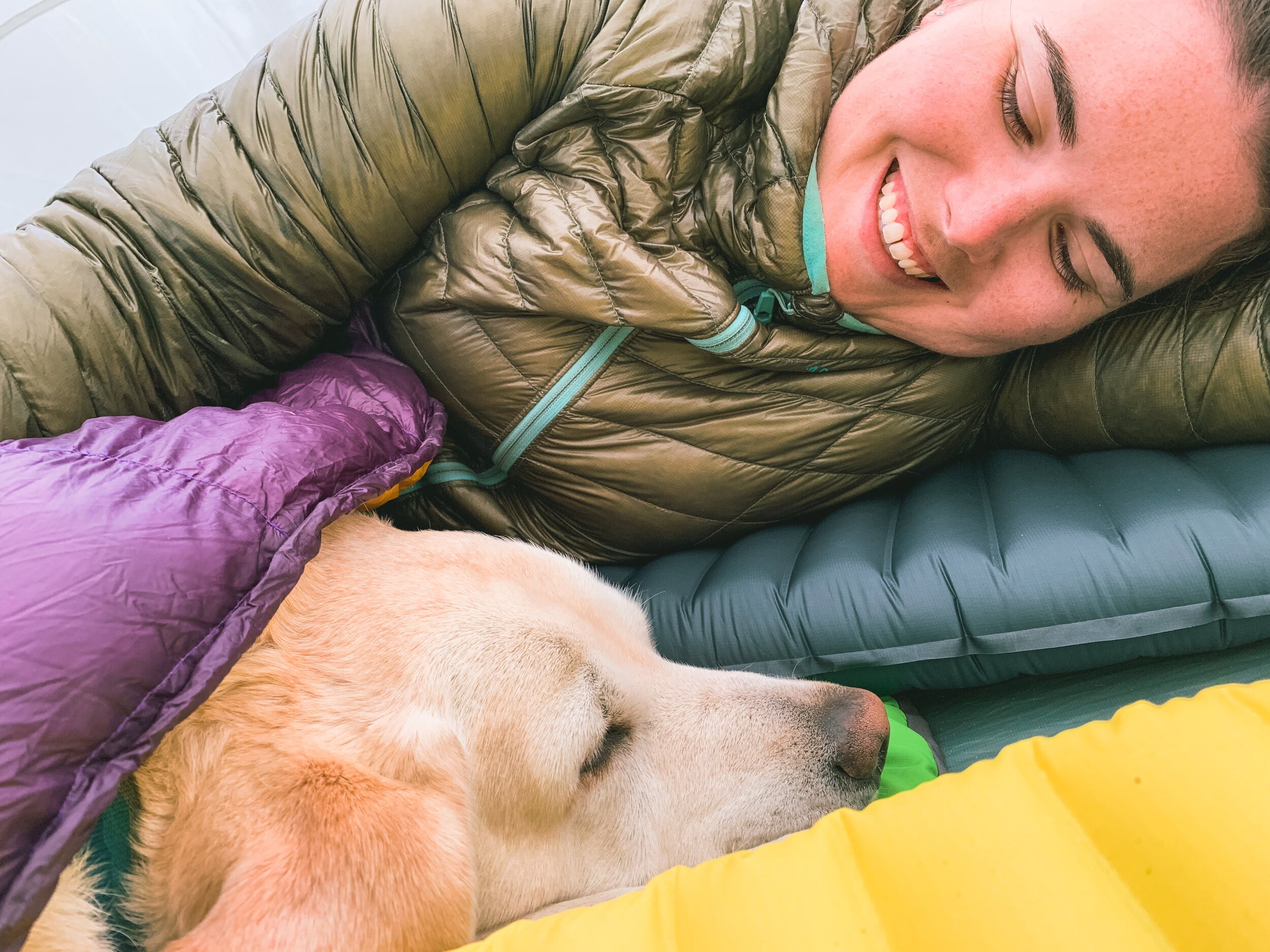My First Backpacking Trip With My Dog
This post contains affiliate links. If you choose to purchase an item with these links, I will earn a small commission at no extra cost to you, and I will be able to continue providing free gear reviews and blog posts! Thanks!
In between hiking the Wonderland and High Sierra Trails this summer, I squeezed in a quick overnighter to a place my mom and I had day-hiked to before - Loch Leven Lakes in Tahoe National Forest. When we were hiking there we noticed the abundance of campsites and thought that it would be a great, easy overnighter from our lakehouse, especially since no permits are required (except for a California Fire Permit).
We also thought it would be an amazing spot for our dog’s first backpacking trip. Riley is an English Yellow Labrador who loves being outside, hiking, and swimming, and is very well behaved. I’d been wanting to take Riley on a backpacking trip for a while, just because I knew she would love it (and I would always feel guilty when she would watch me pack my backpack for trips without her).
We had an overall great trip! The Loch Leven Lakes trail isn’t something super worthy of a long description. The trail isn’t the best maintained and it sees so much traffic since its a relatively short hike to some nice lakes. The trail can be very rocky and rooted in places, and the trail kind of fades away after the second lake, but it is a good beginner trip (with or without a dog!).
Even though I am an experienced backpacker, I would still consider myself a total beginner in backpacking with dogs. There are many other things to take into consideration when camping or backpacking with a dog, so it is important to be prepared! I learned a lot from my first trip, and I’m sure I’ll learn even more as we continue to take Riley on trips!
How Did I Prep?
Found a trail that allows dogs (lucky for us, Tahoe National Forest is incredibly dog friendly) and looked up rules for having a dog on the land. Having day hiked many times in Tahoe National Forest, I already knew the rules surrounding dogs. It is recommended that dogs be on a leash no longer than 6 feet, but dogs are allowed to be off-leash if they are under voice control.
Gathered Riley’s gear. This included a leash, dog pack/ harness, an extra water reservoir, a pad, a padded, insulated “sleeping mat”, a collar light, her booties, a folding water dish, and her dinner & breakfast food + extra treats. Most of the gear I purchased from Ruffwear. I almost brought her cooling pad that attaches to her harness, but the weather forecast was showing mild temperatures.
Assembled my regular backpacking gear (and mom’s).
Check Out My Favorite Dog Gear Below!
Things I Learned
The trip was mostly great! Though every trip is a learning experience, and there were some teaching moments that Riley bestowed on us.
Riley hates her booties. I tried to make her wear them on day hikes and on this trip in order to protect her paws, but she nibbles on them during stops, and she tripped over them multiple times before I decided to take them off of her. Maybe she just needs more practice with them, but I don’t think we’ll be using them anymore, and instead carry Paw Wax for her, and use the paw wax at home to keep her pads healthy.
Riley doesn’t realize that her pack isn’t waterproof and will jump into a swampy area for fun. With her pack on. I try to not keep Riley on her leash when allowed. We usually leash up for the first 0.5-1 mile from the trailhead where there are more people around, but then unleash after that when people are more spread out to allow her to sniff around. She is a courteous hiker, always staying on the trail, and if we drift too far behind her, she stops & turns around and either waits for us to catch up, or trots back to us. However, she does not do this if she sees water. And unfortunately, there was a swampy area right next to the trail that she happily jumped into when she was just out of my eyesight. Which is why the rules exist to keep your dog within eyesight and under voice control. Riley can’t help herself when she sees water though. So I learned a few things from this incident. Even though my sweet pup is generally well-behaved, biology reigns supreme for dogs. She needs to be leashed, for her safety and other’s safety.
Because she needs to be leashed, I need to change my hiking style. Which means, using one or no trekking poles. I tried looping the leash between my hip belt but any slight tug and my belt would loosen and the weight in my pack would fall onto my shoulders. So, I need a free hand to hang on to her. This newer product relieves this problem!
Riley doesn’t like laying on her pad. We set her pad out so she could lay on it outside the tent, but she just wanted to lay in the dirt.
Riley is a good bathroom partner. I can’t say for sure what Riley was thinking when I dug a hole and pooped in it, but once I started doing my business, she did hers. It was pretty funny.
Riley doesn’t care that the Therm-a-rest Uberlite is an ultralight wonder pad. I should have known better than to bring it, but she popped a hole in my new UL inflatable pad. Thankfully, I brought a pad repair and the repair held up great (and continues to hold up). But this is something to keep in mind when backpacking with dogs. Their nails are sharp, even if you regularly trim them, and since Riley is not used to being in a tent, she got really excited and was attempting to walk all over the tent with our stuff inside. In the future, I might only use a CCF pad when backpacking with her.
We forgot a food dish for Riley, but the lid of a bear canister works great! I don’t think I’d bring a separate dish in the future, either. I’d just use her water bowl and then fill it up with water after she’s done eating out of it.
The collar light worked really well when we got into the evening hours. Riley never left our side while in camp, but when we both went to the bathroom in the evening, which was more tucked back in the trees, I could see where she was a lot better because of the light.
Things I’m Still Working On
I had the hardest time getting Riley’s pack to be balanced on her back. I don’t know if its the way she walks or I just didn’t adjust the harness well enough but it was always sliding one way or the other. I need to toy around with the adjustments to see if I can make it work.
I am still unsure if she was good on temperature throughout the night. I draped my quilt over part of her and she didn’t seem too hot. I assumed that if she was too hot she’d end up down at our feet, but she stayed nestled in between us all night long. We saw temps in the mid-40s probably that night, so maybe I need to bring her insulation “coat” if temps get below that, because I don’t want to be cold at night by letting drafts into my quilt either. I do think I can just bring the CCF pad for her to lay on though, instead of the bed + pad.
I’m still not sure if I’m supposed to filter water for her or not. On this trip, I did, just because we had extra water after filtering. She has drank stream water before on day hikes and been fine. I do think dogs can get giardiasis though, so it is probably best to filter.
Biggest Advice
Prep Yourself First:
I don’t think I’d recommend your first backpacking trip to also be your dog’s first backpacking trip. I think our trip was so easy to do just because both my mom and I have backpacked numerous times before. Bringing Riley was an adjustment, but not a drastic change. We already knew our routine and how to set up camp, get water, what food we like to bring, etc. I’d definitely go on a few backpacking trips by yourself/ with other humans first so you know how to take care of yourself and your needs well before throwing a pet into the mix.
Do Training Day Hikes:
This improves your dog’s fitness, stamina, and conditions their paw pads. And, it improves your fitness too! On these hikes, you get a more realistic picture of their weaknesses - do they need work on recall? Do they seem to want to chase squirrels? I knew from hikes that Riley generally freezes when she sees other animals and then turns to find me to see what my reaction is. However, she does not do the same with humans - she is an attention hog and assumes that the humans have love and treats to give her. While she doesn’t bulldoze them over, she will approach humans, which is something not everyone appreciates on hikes. You will also learn cues they give you: gnawing at paws might mean their feet hurt. Laying down means they’re tired. You can’t speak to your dog, but you can read their body language to see how they are doing. Learning these things about your dog will give you a better idea of how much more training they need, or maybe even steer you to another hiking area for your first trip.
Work On Voice Recall and Training:
Your dog should be trained. Riley is less trained than I would like: she will sometimes ignore my calls to her when on trail. 100% voice control is hard to attain with dogs, but its achievable. With self-training or professional training, you can do it. You just need to put the effort (or money) into it. If your dog is not fully trained, they should be on a leash.
Practice Leave No Trace:
You need to be prepared to handle your dog’s waste, just like your own. In most places, you’ll be able to dig a cat hole and poop in it yourself, and you can do the same with your dog. But you’ll probably have to nudge your dog’s poop into the hole. If you are backpacking or hiking somewhere where you can’t dig a hole (above treeline, in the desert), you need to pack your dog’s poop out, just like yours. If you can’t handle toting around your dog’s poop for your whole trip, leave them at home.
Start Small:
Unless you are already regularly doing long day hikes with your dog, you should probably choose a trail that is shorter. I know Riley isn’t used to hiking two days in a row, and I could tell mid-way through our descent on day 2 that she was ready to be done. Remember that you need to hike out the same amount that you hiked in! If your dog isn’t fit, they will struggle, and possibly injure themselves or die if you push them too hard. Don’t put more than 10% of their body weight in their pack, and start even smaller for the first few times. You can even do practice day hikes with their pack loaded to get them used to the weight. You should also plan on taking more breaks than usual. While humans are pretty good at sweating to keep our bodies cool, dogs have a harder time with this. Taking breaks, especially in the shade, help them out a lot!
Take a Doggy First Aid Course:
Just like you should know some basic first aid for yourself when you go into the wilderness, you should know how to take care of your dog if shit hits the fan. This includes being able to self-evacuate, or carry them out of the wilderness if they can no longer support themselves. REI generally offers classes on Wilderness Dog First Aid by partnering with veterinarians in the area, and I’m sure you could find information from your vet if an REI isn’t available to you. This also includes having your dog vaccinated, and possibly on certain medications to prevent tick and water-borne illnesses. You might want to bring along a dog first aid kit, too!
Do Your Research:
Doing research is important. Dogs are not allowed everywhere, and every place has different restrictions with dogs on hiking trails. Usually an Internet search will give you information on how to recreate responsibly with your dog. In general in the USA, National Parks forbid dogs on hiking trails, and they cannot be off-leash. There are a few notable exceptions: Acadia, Shenandoah, Cuyahoga Valley, Mammoth Cave, Great Sand Dunes, and Petrified Forest National Parks all allow dogs on many miles of trails. The Grand Canyon, Zion, and Yosemite are not as dog friendly as the above, but have a couple of frontcountry trails that dogs can use. National Forests and BLM land are generally more dog-friendly. State Parks and Open Space Preserves are a mixed bag and varies depending on where you live! But even if you can’t find this information online, call the ranger station where you’d like to visit to hear about their rules on dogs. It is the responsibility of all dog owners to follow the rules, Leave No Trace, and be good wilderness stewards so dogs can still have access to our beautiful wild spaces. It only takes a few bad apples to ruin it for everyone. And remember: it is never the dog’s fault. Just irresponsible humans that own the dog. So don’t be that irresponsible human!
Questions? Comments? Suggestions for me about how to be a better dog backpacker? Leave them below! Hopefully I’ll be doing more backpacking with Riley before she becomes too old, and I’ll be able to write an update!
